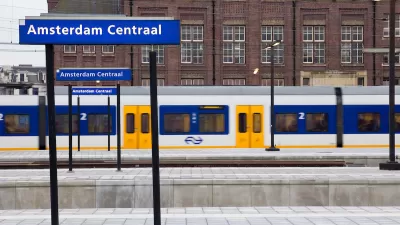Massacre on a Paris-bound train was averted in France on Friday due to the courageous actions of three Americans, one in the Air Force another in the Oregon National Guard, who rushed and subdued a Moroccan man armed with an AK-47 and a handgun.
New York Times reporter Adam Nossiter gives the play-by-play of how three Americans tackled and subdued the suspected terrorist, bent on the massacre of civilians, while the Thalys train was speeding at 186 mph from Amsterdam to Paris (see map of train route and description at base of post).
"Their actions saved many lives on the train, which was packed with over 500 passengers, according to French officials," writes Nossiter. "The attack took place in Oignies, near the historic town of Arras (France)."
"French authorities said that three people were injured. Two were injured seriously - one with a gunshot wound, the other a knife wound," reports The Telegraph.
Alek Skarlatos, a [22-year-old] specialist in the National Guard from Oregon who was vacationing in Europe with his [22-year-old] Air Force friend, Airman First Class Spencer Stone and another American, Anthony Sadler [a 23-year-old student at Sacramento State University], looked up and saw the gunman.
The gunman was "identified by Interior Minister Bernard Cazeneuve of France as a 26-year-old Moroccan man known to the Spanish authorities as a member of 'the radical Islamist movement'," writes Nossiter.
Mr. Skarlatos, who was returning from a deployment in Afghanistan, looked over at the powerfully built Mr. Stone, a martial arts enthusiast. “Let’s go, go!” he shouted.
The Americans were unarmed. Stone tackled the gunman first.
But the gunman fought back furiously, [pulled out a cutter and began] slashing with his blade, slicing Mr. Stone in the neck and hand and nearly severing his thumb. Mr. Stone did not let go.
The AK-47 had fallen to the gunman’s feet. Mr. Skarlatos picked it up and “started muzzle-thumping him in the head with it,” he said, until he was unconscious.
Bleeding heavily, Mr. Stone went to the aid of a gunshot victim, Mr. Sadler said. “Even though he was injured, he went to help the other man who was injured,” he said. “Without his help, he would have died.”
According to one accounting in The Telegraph, the gunman "was carrying a short-stocked Kalashnikov assault rifle, at least five magazines of ammunition, a handgun and knives, according to witnesses."
In addition to the heroism of the Americans and Chris Norman (shown in video interview), the British man on board the train who helped tie up the attacker, luck was on the side of the passengers. According to Mr. Skarlatos, "(t)he suspect’s guns had malfunctioned, and he had not had the competence to fix them."
"Now sharp questions are being asked about Europe’s security measures after a man who had been flagged by counterterrorism authorities as a potential risk was allowed onto the continent’s vital rail system without any security checks," writes Michael Birnbaum for The Washington Post.
Despite the French and Belgian promises of stepped-up security, on one Saturday high-speed train trip between Brussels and Paris — the same route on which the attack took place — there were no special bag screenings, identity checks or uniformed security officers visible on the train.
The gunman has been identified as "Ayoub El-Khazzani, a Moroccan national who lived in Spain until last year and reportedly travelled to Syria in the past year to fight with the Islamic State," report six correspondents for The Telegraph. They indicate that he had boarded the train in Brussels.
Spencer was released from a French hospital Saturday afternoon, reports CBS News.
According to Wikipedia's description of Thalys, "(j)ourneys from Brussels (Brussels-South) to Paris (Gare du Nord) are normally 1 hour, 22 minutes, for a distance of approximately 300 kilometres (190 mi). Peak speed is 300 km/h (186 mph) on a dedicated high-speed railway track which is electrified at 25 kV AC OHLE."
FULL STORY: NYT: A Shot, a Glimpse of an AK-47, and U.S. Servicemen Pounced on Gunman on Train

Alabama: Trump Terminates Settlements for Black Communities Harmed By Raw Sewage
Trump deemed the landmark civil rights agreement “illegal DEI and environmental justice policy.”

Study: Maui’s Plan to Convert Vacation Rentals to Long-Term Housing Could Cause Nearly $1 Billion Economic Loss
The plan would reduce visitor accommodation by 25% resulting in 1,900 jobs lost.

Planetizen Federal Action Tracker
A weekly monitor of how Trump’s orders and actions are impacting planners and planning in America.

Wind Energy on the Rise Despite Federal Policy Reversal
The Trump administration is revoking federal support for renewable energy, but demand for new projects continues unabated.

Passengers Flock to Caltrain After Electrification
The new electric trains are running faster and more reliably, leading to strong ridership growth on the Bay Area rail system.

Texas Churches Rally Behind ‘Yes in God’s Back Yard’ Legislation
Religious leaders want the state to reduce zoning regulations to streamline leasing church-owned land to housing developers.
Urban Design for Planners 1: Software Tools
This six-course series explores essential urban design concepts using open source software and equips planners with the tools they need to participate fully in the urban design process.
Planning for Universal Design
Learn the tools for implementing Universal Design in planning regulations.
Caltrans
Smith Gee Studio
Institute for Housing and Urban Development Studies (IHS)
City of Grandview
Harvard GSD Executive Education
Toledo-Lucas County Plan Commissions
Salt Lake City
NYU Wagner Graduate School of Public Service




























